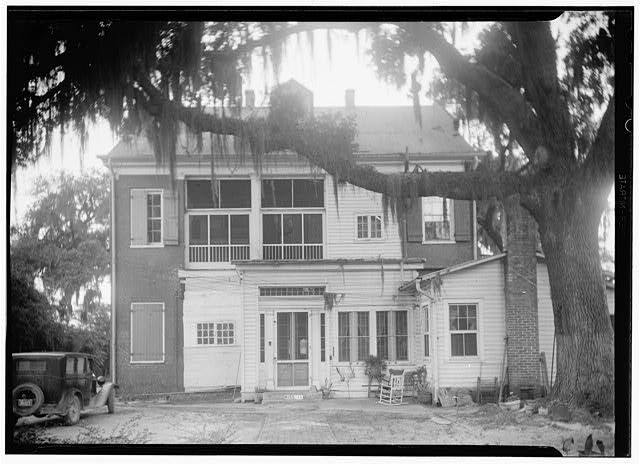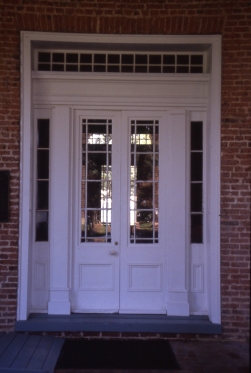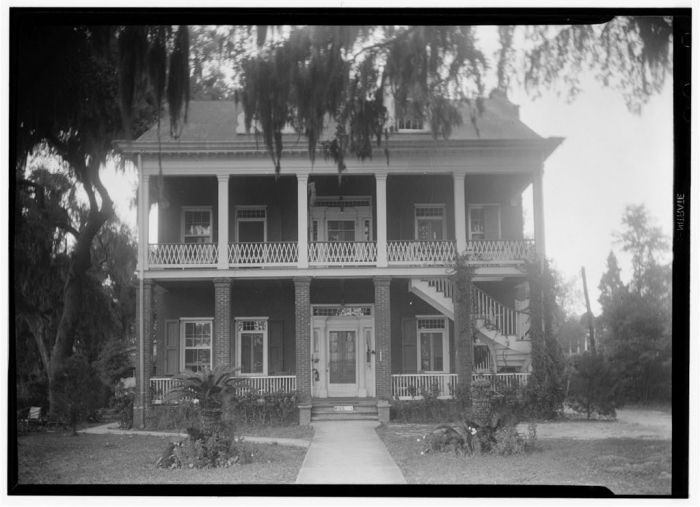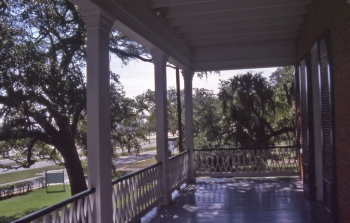
Historic American Buildings Survey James Butters, Photographer April 23, 1936 REAR (NORTH ELEVATION)
from National Register nomination, August 1976:
As one of the most substantial and elaborate of the vacation homes constructed on the Mississippi Gulf Coast during the early peak period of the area’s popularity in the 1850s, the Pradat/Toledano/Philbrick/Tullis House is both architecturally and historically significant. Architecturally, the Tullis House is important as a sophisticated blend of academic and regional design elements, practically executed with the best of available local building materials. . . . Historically, the Tullis property gains significance through its early connection with prominent representatives of the Creole culture which dominated New Orleans and the Mississippi Gulf Coast in the nineteenth century, and because of its position in the story of Biloxi’s growth and development as a resort community.
from The Buildings of Biloxi: An Architectural Survey, p. 71:
The main house is the most striking of Biloxi’s large early houses, as it is completely different from all others in the city and has the richest detail of any. Particularly notable are the entrance doorway, the main cornice, and the dormers. Both major entrances on the main facade have fluted Doric columns supporting an entablature, which recedes over the door opening . . . . The great roof cornice exuberantly juts out over the front gallery. It is boldly profiled with a dentil course, a row of modillions under the corona, and topping all a very large cyma recta moulding which swells outwards in a grant curve.
The dormers match the cornice in vitality, having great baroque scroll consoles flanking fluted pilasters with [a] narrow segment of entablature above and a single triglyph. The dormers on Dunleithin Natchez have similar large consoles. The windows are round headed with gothic top sash. The pediments of the dormers have a deep molding that continues along the sides as a cornice. The elegant stairway, once an outstanding feature of the front gallery, was swept away by Hurricane Camille in 1969. The gallery railing on the second floor is the accordion or multiple-X type, the only one remaining in Biloxi (the Robinson-Maloney House and the Montross Hotel being two other buildings known to have had this type of railing).
On the interior there are only two late Greek Revival mantles left, both rather plain, one wood and one marble. Moldings on the interior architrave trim and door panels have a gothic profile. An interesting feature of the interior is the open beamed ceiling of beaded joists.
On the morning Hurricane Katrina hit the Gulf Coast, the Tullis-Toledano House, in my opinion the most gracious and graceful beach house on the Coast, was horribly destroyed by the Grand Casino barge, which floated from its moorings in an act of pure negligence, and landed right on top of the Tullis property. The grand live oaks fronting the property and shielding it from the road were also victims of the barge. More than any other devastation of Katrina, this event symbolizes to me the brutishness of our modern consumer-oriented culture in its mindless destruction of all that is beautiful and humane from our history. It’s not clear that Tullis was already down or not, but given that she took 6 feet of raging water in Camille and survived, it’s probable that the barge is what took her down.
I had thought to include photos of the barge, but decided against it. Tullis deserves to be remembered for her beauty and grace, not for the last few horrible moments of her life or the nasty aftermath. Maybe the Tullis wouldn’t fit the “new” Coast and her time had come, but I would have preferred to see if she could have withstood Katrina like she survived Camille, bruised and battered maybe, but ready to face the beach as she had for over 150 years.
——————————————
This post is the last in the week-long Katrina’s Lost Landmarks series. Read other posts in the series:
See also Katrina Survivors series:
Categories: Biloxi, Demolition/Abandonment, Gulf Coast, Historic Preservation, Hurricane Katrina, Lost Mississippi



Wow. I wish I’d been right about the Tivoli if only so I wouldn’t have had to hear this horror story.
LikeLike
Yeah, we’ll have to tell the Tivoli story at some point, but since it didn’t go down until after Katrina, I thought Tullis should be today. Isn’t it terrible? Makes me really hate the casinos even more than I did before.
LikeLike
Of all the losses from Katrina, this one was probably the saddest. There is indeed something metaphorical about a grand old house being obliterated by a casino barge. I wish there were the resources to rebuild the Tullis. I suppose that is far from anyone’s mind these days.
LikeLike
I grew up in Biloxi in the 1970s and 1980s and I LOVED this house. Surrounded by all the other huge white beautiful houses that lined the beach, Tullis Manor’s red bricks really stood out as unique & original. I remember visiting at Christmastime once and they had real candles on the Christmas tree with buckets of water sitting next to it — very exciting for a kid! And I went to an awesome Easter egg hunt on the lawn there once.
LikeLike
I have a replica of The Manor that was given to me at Casino Magic many yrs ago as well as the Lighthouse off of 90…will sell to the highest bidder.
LikeLike
Do have you a picture or a starting price?
LikeLike
Right wing Americans couldn’t save their own history if their lives depended on it. Profit rules all. It’s fitting that treaures of the south were destroyed not only by global warming, but also by right-wing ignorance, incompetence and outright greed. Appalling that such a national loss occurred in such a historical part of the country. BUildings like this don’t grow on trees, and yet the local yokels or the state fathers could be bothered to think or spend what it took to preserve these treasures. What an embarassment to the people who labored to build these buildings in the first place. (slaves of course).
LikeLike
Why are you making this political? I am very conservative in my leanings—perhaps you would call me “right wing” although I detest that label—but I am also a passionate preservationist and an ardent defender of history and the environment. Please stop lumping people together according to your stereotypes and preconceived ideas.
LikeLike